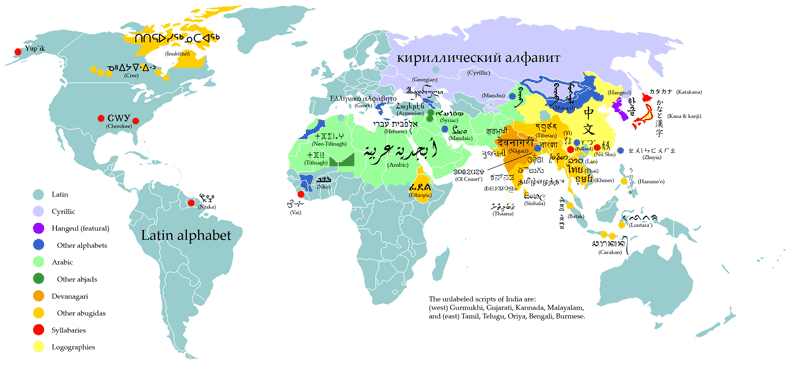2.1.1. The next table shows the relationship between the letters of the Greek alphabet and its derivatives, the Latin alphabet and the (newer) Cyrillic alphabet.
|
GREEK |
LATIN |
CYRILLIC |
|
Α α Alpha |
A a |
А а |
|
Β β Beta |
B b |
Б б, В в |
|
Γ γ Gamma |
C c, G g |
Г г |
|
Δ δ Delta |
D d |
Д д |
|
Ε ε Epsilon |
E e |
Е е, Ё ё, Э э |
|
Ζ ζ Zeta |
Z z |
Ж ж, З з |
|
Η η (H)Eta |
H h |
И и, Й й |
|
Θ θ Theta |
|
|
|
Ι ι Iota |
I i, J j |
|
|
Κ κ Kappa |
K k |
К к |
|
Λ λ Lambda |
L l |
|
|
Μ μ Mu |
M m |
М м |
|
Ν ν Nu |
N n |
Н н |
|
Ξ ξ Xi |
|
|
|
Ο ο Omicron |
O o |
О о |
|
Π π Pi |
|
П п |
|
Ρ ρ Rho |
P p, R r |
Р р |
|
Σ σ ς Sigma |
S s |
С с |
|
Τ τ Tau |
T t |
Т т |
|
Υ υ Upsilon |
U u, Y y, W w |
У у |
|
Φ φ Phi |
|
Ф ф |
|
Χ χ Chi |
X x |
Х х |
|
Ψ ψ Psi |
|
|
|
Ω ω Omega |
|
|
|
F Digamma |
F f |
|
|
Q Qoppa |
Q q |
|
2.1.2. The Europaio Alphabet is similar to the English (which is in fact borrowed from the late Latin abecedarium), except that the C has a very different sound, similar to that of G. We also consider some digraphs part of the alphabet, as they represent original Europaio sounds, in contrast to those digraphs used mainly for transcriptions of loan words.
NOTE 1. The Latin alphabet was borrowed in very early times from a Greek alphabet and did not at first contain the letter G. The letters Y and Z were introduced still later, about 50 BC
NOTE 2. The Europaio names of the consonants are as follows - B, be (pronounced bay); Bh, bhe; C, ca (Ga); Ch, cha (Gha); D, de (day); Dh, dhe (dhay); F, ef; G, ge (gay); Gh, ghe (ghay); H, ha; K, ka; L, el; M, em; N, en; P, pe; Q, qu; R, er; S, es; T, te; V, ve; W, wa; X, xa (cha); Z, zet
2.1.3. The Latin character C originally meant G (probably due to Etruscan influence), a value always retained in the abbreviations C. (for Gaius) and Cn. (for Gnaeus).
NOTE. In early Latin C came also to be used for K, and K disappeared except before in a few words, as Kal. (Kalendae), Karthago. Thus there was no distinction in writing between the sounds [g] and [k]. This defect was later remedied by forming (from C) the new character G. Y and Z were introduced from the Greek about 50 B.C., and occur only in loan words in Europaio.
2.1.4. The Latin [w] sound developed into Romance [v]; therefore V no longer adequately represented [w] and latin alphabet had to develop an alternative. Europaio uses V mainly for loan words, representing [v], while W is left for the consonantal sound of u, although not always.
NOTE. V originally denoted the vowel sound u (oo), and F stood for the sound of our consonant [w] (like in Greek digamma). When F acquired the value of our f, V came to be used for the sound [w] as well as for the vowel [u].
2.1.5. The consonant cluster /ks/ was in Ancient Greece written as Chi 'X' (Western Greek) or Xi '' (Eastern Greek). In the end, Chi was standardized as [kh] ([x] in modern Greek), while Xi represented /ks/. In Europaio, the X stands for [x], as in the Greek and Cyrillic alphabets, and not as in English.
NOTE. The Etruscans took over X from older Western Greek, therefore, it stood for /ks/ in Etruscan and Latin, and in most of the languages which today use an alphabet derived from the Roman, including English.
 Map of the Writing systems of the world today. The Latin alphabet is clearly the most widely used in the World, as well as in IE languages, especially the European. [
Map of the Writing systems of the world today. The Latin alphabet is clearly the most widely used in the World, as well as in IE languages, especially the European. [ ]
]